Abstract
The primary objective of this study is to explore the potential of iron slag and copper slag as alternatives to traditional sand in concrete, with an emphasis on assessing the impact on flexural strength. This investigation experimented with three distinct mixtures: a combination of cement with iron slag and copper slag, a blend of cement with sand and iron slag, and a mixture of cement with sand and copper slag. The study varied the proportions of the combinations and the duration of curing, which included intervals of 7, 28, 56, and 90 days, to serve as independent variables. The experimental results suggested that a mixture of iron slag and copper slag in a ratio of 40:60, in conjunction with cement, yielded the most promising results, with an enhancement in flexural strength of up to 92% observed over the 90-day curing period compared to the initial 7-day strength measurement. The findings from this research offer valuable insights into the utilization of waste materials in the construction industry, addressing crucial concerns related to environmental sustainability and solid waste management. The implications of this study extend beyond mere technical outcomes, emphasizing the need for innovative approaches in the construction sector that contribute to ecological conservation and waste reduction.
1. Introduction
The quest for sustainable and innovative construction materials has led to the exploration of various supplementary cementitious materials that enhance the properties of concrete. Among these materials, copper slag and iron slag have gained significant attention due to their potential to improve the mechanical properties of concrete. The incorporation of copper slag and iron slag as partial replacements for fine aggregate offers a unique opportunity to develop composite materials with enhanced flexural strength [1,2,3]. Traditional concrete, composed primarily of cement, aggregates, and water, has limitations in terms of both environmental impact and mechanical performance [4]. By integrating industrial byproducts such as copper slag and iron slag, not only can the disposal of these waste materials be addressed, but also the composite’s mechanical properties can be optimized [5]. Copper slag, a byproduct of copper extraction processes, possesses pozzolanic properties that can contribute to the development of strong and durable cementitious materials [6]. Similarly, iron slag, derived from iron and steel manufacturing, exhibits latent hydraulic characteristics that make it an attractive candidate for cement replacement [7]. The focus of this exploration is to understand how the judicious mixing of copper slag and iron slag with cement can lead to improvements in the flexural strength of the resulting composite. By leveraging the unique properties of copper slag and iron slag, we aim to unravel the synergistic effects that their combination can offer. Also, in practical situations, the increased flexural strength of concrete structures allows them to withstand higher bending and shear forces, making them more suitable for supporting heavy loads, reducing deflection, and resisting external forces.
By using iron slag and copper slag as partial replacements for traditional aggregates, there is a reduced use of natural resources, leading to more sustainable construction practices. Iron slag and copper slag can contribute to the formation of more durable concrete due to their inherent properties, such as resistance to chemical attacks and corrosion. This is especially beneficial in aggressive environments, such as marine or industrial settings. Slag-containing concrete often exhibits better resistance to freeze–thaw cycles, which is crucial in areas with cold climates. As the construction industry embraces sustainable practices and seeks to reduce its ecological footprint, the incorporation of waste byproducts into construction materials becomes not just a practical solution, but a transformative approach. The objectives of this research were to:
- Conduct a comprehensive characterization of copper slag and iron slag, including their chemical composition, particle size distribution, mineralogy, and physical properties;
- Develop and optimize concrete mix designs that incorporate appropriate proportions of copper slag, iron slag, and cement to achieve improved flexural strength while maintaining other essential properties such as workability, durability, and compressive strength;
- Perform laboratory tests to assess the flexural strength of concrete specimens containing varying percentages of copper slag and iron slag;
- Analyze how the interplay between these materials influences the flexural strength of the composite.
2. Materials and Methods
2.1. Cement
The Ordinary Portland Cement (OPC) from Ultratech Cement Limited, Udupi, Karnataka, India was used in this research. The physical and chemical properties of the cement are provided in Table 1.

Table 1.
OPC (43 Grade) properties as per IS 8112-1989.
2.2. Aggregates
The coarse aggregates, specifically of 20 mm and 10 mm size, and fine sand were procured from a local crusher. These aggregates are commonly used in conventional concrete mixes. A gradation analysis was performed on the aggregates, confirming their compliance with the specified specification criteria.
2.3. The Slags
Copper slag is produced during the smelting of copper, where it separates based on density, allowing impurities to rise to the surface and be skimmed off. These impurities are then directed to a low-temperature water basin for solidification, and crushed into a robust solid. Copper slag is generally harder and denser than natural sand or coarse aggregates, and when used as a partial replacement, it can enhance the mechanical properties of concrete due to its high hardness and durability, leading to improvements in both compressive and flexural strengths [8]. Iron slag, a byproduct of iron and steel production, forms at high temperatures during various metallurgical processes.
The molten iron settles in the smelting furnace, with the heavier impurities and slag materials rising to the surface. Iron slag was selected for its richness in calcium, silicon, and aluminum compounds [9]. When added to concrete mixtures, it undergoes a hydration process similar to Portland cement, forming additional calcium silicate hydrates (C-S-H) that contribute to the concrete’s strength and stiffness, thereby reducing cracking and improving flexural behavior.
2.4. Silica Fume
The high-strength concrete production involved the incorporation of silica fume, introduced into the mix as a powdered substance.
2.5. Superplasticizer
A polynaphthalene sulphonate-based superplasticizer, containing 40% active solids, was employed to enhance the workability of the high-strength concrete.
3. Laboratory Testing Program
Table 2 provides the mix proportions of concrete. Each component was measured and placed in separate containers. The materials were combined in a rotating pan, adhering to the guidelines of ASTM C192-98. The mixing process lasted for approximately 4 min. The mixes were then compacted using a vibrating table. To verify compliance with the design specifications and to assess the impact of copper slag replacement on workability, the fresh concrete’s slump was measured. After 24 h of water curing, specimens were demolded and tested at room temperature at predetermined intervals. Slump (mm) and compaction factor values for iron slag were in the range of 71 to 60 and 0.88 to 0.85, respectively, for replacements from 0% to 100% in increments of 20%. For copper slag replacements of 0%, 20%, 60%, 80%, and 100%, the values were 60, 85, 92, 103, and 105 for slump, and 0.85, 0.93, 0.94, and 0.95 for compaction factor, all within the acceptable range.

Table 2.
Mix proportions (kg/m3).
Tests were conducted in accordance with IS:516-1969. Cubes of 150 mm × 150 mm × 150 mm were fabricated for each mixture to assess compressive strength. Cylinders of 150 mm diameter and 300 mm length were prepared to determine split-tensile strength. Beams of 100 mm × 100 mm × 500 mm were cast to evaluate flexural strength (modulus of rupture). After curing, samples were tested for flexural strength at 7, 28, 56, and 90 days.
4. Results and Discussion
4.1. Test Results
The flexural strength of specimens composed of cement, iron slag, and copper slag, subjected to air-cooling, is illustrated in Table 3 and Figure 1. In the experiments, half of the cement was mixed with distributed proportions of iron slag and copper slag. With 100% iron slag and cement, the flexural strength increased by 86.4% from 7 to 90 days of curing, and for 100% copper slag and cement, the increase was 84.8% for the same period. The 80–20% (iron slag–copper slag) combination resulted in a 38.8% increase in flexural strength, while the 20–80% (iron slag–copper slag) combination saw a 49.8% increase. For a 40–60% (iron slag–copper slag) combination, the increase in flexural strength reached a notable 92%.

Table 3.
Flexural strength of cement with iron slag and copper slag.
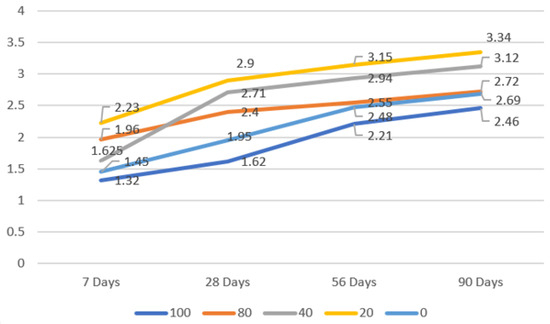
Figure 1.
Variation in flexural strength of cement with iron slag and copper slag.
As demonstrated in Table 4 and Figure 2, the flexural strength of cement mixed with sand and iron slag and subjected to air cooling was analyzed. The mix proportions were adjusted so that half of the mixture was cement and the other half was a combination of sand and iron slag. Notably, a mixture of 100% sand with cement exhibited an increase in flexural strength of 38.34% over a cooling period from 7 to 90 days. A mixture of 100% iron slag with cement showed an 84.4% increase in strength for the same period. The 80–20% (sand–iron slag) blend resulted in a 39.7% increase, while the 20–80% (sand–iron slag) blend showed a 13.1% increase. An intermediate mixture of 40–60% (sand–iron slag) produced a significant increase in flexural strength of 29.8%.

Table 4.
Average flexural strength of cement with sand and iron slag.
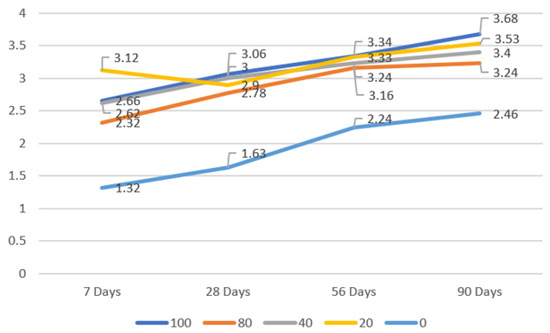
Figure 2.
Variation of flexural strength of cement with sand and iron slag.
The examination of flexural strength incorporating cement, sand, and copper slag subjected to air cooling is detailed in Table 5 and depicted in Figure 3. The experimental design involved combining half of the cement with an equal half mixture of sand and copper slag. It was found that a blend of 100% sand with cement increased the flexural strength by 38.72% over a cooling period from 7 to 90 days. Similarly, a blend of 100% copper slag with cement resulted in an increase in flexural strength by 86.1% over the same period. When analyzing the 80–20% (sand–copper slag) mixture, there was a 35% increase in flexural strength, whereas the 20–80% (sand–copper slag) mixture resulted in a 64% increase. Notably, a 40–60% (sand–copper slag) mixture led to an increase in flexural strength of as much as 62.7%.

Table 5.
Average flexural strength of cement with sand and copper slag.
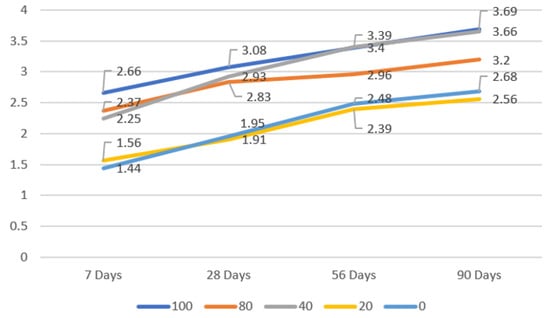
Figure 3.
Variation in flexural strength of cement with sand and copper slag.
The investigations thus far reveal that the most effective composition for enhancing flexural strength is a cement mixture with 40% iron slag and 60% copper slag. This specific blend yields a remarkable increase in flexural strength—up to 92% when air-cooled from 7 days to 90 days. Comparable mixtures using cement with either iron slag or copper slag alone are shown to have an approximate 85% increase in flexural strength over the same cooling period. For substantial improvements in flexural strength, ranging from 60 to 65%, combinations of sand and copper slag in ratios of 20–80 or 40–60 are recommended. Research has elucidated several factors that contribute to the observed enhancements in flexural strength with these composite mixtures. The pozzolanic activity inherent to both copper slag and iron slag is particularly influential [10].
These industrial by-products display properties that enable them to react with calcium hydroxide, leading to the formation of cementitious compounds such as calcium silicate hydrates, which strengthen and add durability to concrete. Other contributing factors include improved particle packing [11], microstructural refinement [12,13,14,15], mitigation of alkali–silica reaction (ASR) [16,17,18], and enhanced curing and water retention [19,20]. Additionally, the potential bimetal activation due to the combination of copper and iron slag may produce synergistic effects that further enhance the concrete’s physical properties [10]. These findings underscore the synergistic potential of combining slag materials, each with unique properties, to substantially improve the performance of concrete, thus highlighting an innovative avenue for advancing sustainable construction methodologies.
4.2. Two-Way Analysis of Variance
A two-way Analysis of Variance (ANOVA) was performed to ascertain if significant variations exist in the flexural strength of the cement composites, influenced by the combination proportions and the duration of cooling. The analysis indicated that the flexural strength of the cement composite with iron slag and copper slag varied significantly. This was true both for the different material proportions and for the number of cooling days (, ; , ), as shown in Table 6. Residual plots depicted in Figure 4 suggest a normal distribution of the data and the spread of data points around the mean, confirming the model’s adequacy. Standard deviation (S) is reported at 0.1635, with the model explaining 95.11% of the variance (), adjusted for degrees of freedom ().

Table 6.
Two-way ANOVA of cement with iron slag and copper slag.
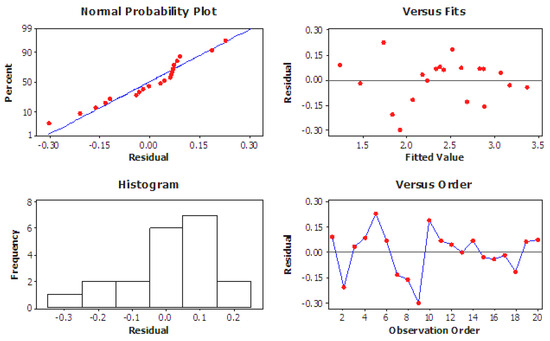
Figure 4.
Residual plots for cement with iron slag and copper slag.
Further analysis was conducted for the combination of cement with sand and iron slag composite. Significant differences were found in flexural strength, influenced both by the proportions of cement, sand, and iron slag and by the cooling duration (, ; , ), as detailed in Table 7. The normality of distribution and the spread of data points around the mean, as shown in the residual plots (Figure 5), validate the statistical model’s assumptions.

Table 7.
Two-way ANOVA of cement with sand and iron slag.
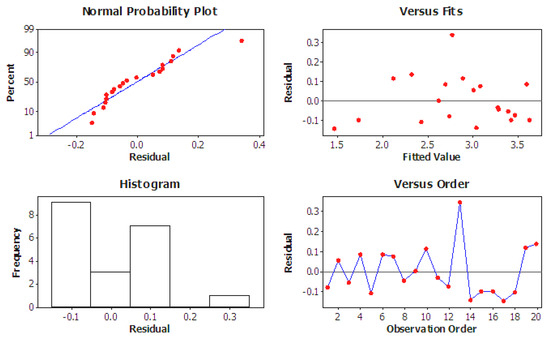
Figure 5.
Residual plots for cement with sand and iron slag.
Here, the standard deviation (S) is 0.1555, and the model’s explanatory power is very high, with an value of 95.97% and an adjusted of 93.61%.
Continuing with the statistical evaluation, the combination of cement with sand and copper slag composite was also analyzed. There was a significant variation in the flexural strength attributed to both the mix proportions (cement, sand, and copper slag) and the duration of cooling (, ; , ), as presented in Table 8. The normal distribution of the data and the consistency around the mean are depicted in the residual plots shown in Figure 6. The standard deviation (S) is recorded at 0.1555, with an value of 95.97% and an adjusted value of 93.61%, indicating a high level of model fit.

Table 8.
Two-way ANOVA of cement with sand and copper slag.
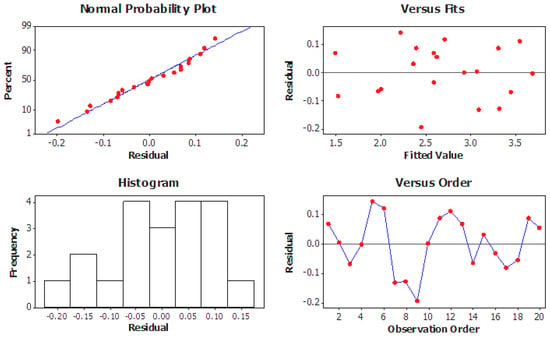
Figure 6.
Residual plots for cement with sand and copper slag.
5. Conclusions
The quest for environmentally friendly construction materials with optimal physical and chemical properties is ongoing. Copper slag and iron slag have risen to prominence due to their advantageous properties and their role in industrial waste management. The examination of flexural strength is particularly important when integrating iron slag and copper slag into concrete. This allows for an assessment of how these materials affect the composite’s behavior under bending loads, which is crucial for designing structurally sound and sustainable concrete elements. From this research, several conclusions have been drawn. Firstly, all three combinations of iron slag and copper slag used with cement as a substitute for sand, either fully or partially, have proven effective in enhancing flexural strength. Specifically, a 40–60% mixture of iron slag and copper slag was the most efficacious, showing an increase in flexural strength of up to 92%. This was followed by mixes of 100% iron slag and 100% copper slag with cement, both of which exhibited an average increase in strength of about 85%. The two-way ANOVA statistical analysis confirmed significant differences in flexural strength across the mix proportions and curing durations tested.
The primary limitation of this study is its sole focus on flexural strength, without consideration of other mechanical properties such as tensile and compressive strength, which suggests avenues for future research. While the results indicate potential for enhanced flexural strength, further investigation is needed into long-term durability, real-world structural applications, and compatibility with other supplementary materials. Moreover, practical aspects such as mix design optimization and construction practices must be addressed prior to broad application. In conclusion, this study substantiates the effectiveness of using iron slag and copper slag as sand replacements to improve concrete’s flexural strength. The encouraging findings advocate for more sustainable and efficient construction practices and open new pathways for optimizing structural components in the built environment.
Author Contributions
Conceptualization, R. and A.S.; methodology, R.; software, S.; validation, A.S. and R.; formal analysis, A.S.; investigation, S.; resources, R.; data curation, R.; writing—review and editing, R.; visualization, S.; supervision, R.; project administration, R. All authors have read and agreed to the published version of the manuscript.
Funding
This research received no external funding.
Institutional Review Board Statement
Not applicable.
Informed Consent Statement
Not applicable.
Data Availability Statement
All the data used in the experiment has been made available in the present article.
Acknowledgments
We place on record the encouragement and support given to us by Manipal Academy of Higher education, Manipal for providing us with the facilities to the preparation of specimen and to the carrying out of the laboratory tests.
Conflicts of Interest
The authors declare no conflicts of interest.
References
- Al-Jabri, K.S.; Al-Saidy, A.H.; Taha, R. Effect of copper slag as a fine aggregate on the properties of cement mortars and concrete. Constr. Build. Mater. 2011, 25, 933–938. [Google Scholar] [CrossRef]
- Chithra, S.; Kumar, S.S.; Chinnaraju, K. The effect of Colloidal Nano-silica on workability, mechanical and durability properties of High Performance Concrete with Copper slag as partial fine aggregate. Constr. Build. Mater. 2016, 113, 794–804. [Google Scholar] [CrossRef]
- Jenifer, J.V.; Brindha, D.; Jebarani, J.A.S.; Venkadapriya, S.; Pandieswari, M. Mechanical and microstructure properties of copper slag based basalt fiber reinforced concrete. Mater. Today Proc. 2023, 1, 12–25. [Google Scholar]
- Alvi, I.H.; Li, Q.; Hou, Y.; Onyekwena, C.C.; Zhang, M.; Ghaffar, A. A critical review of cement composites containing recycled aggregates with graphene oxide nanomaterials. J. Build. Eng. 2023, 1, 105989–105997. [Google Scholar] [CrossRef]
- Mohanty, I.; Saha, P.; Patra, S.R.; Jha, S.K. Waste to valuable resource: Application of copper slag and steel slag in concrete with reduced carbon dioxide emissions. Innov. Infrastruct. Solut. 2023, 8, 122–134. [Google Scholar] [CrossRef]
- Mirnezami, S.; Hassani, A.; Bayat, A. Evaluation of the effect of metallurgical aggregates (steel and copper slag) on the thermal conductivity and mechanical properties of concrete in jointed plain concrete pavements (JPCP). Constr. Build. Mater. 2023, 367, 129532–129546. [Google Scholar] [CrossRef]
- Ghouleh, Z.; Guthrie, R.I.; Shao, Y. High-strength KOBM steel slag binder activated by carbonation. Constr. Build. Mater. 2015, 99, 175–183. [Google Scholar] [CrossRef]
- Al-Jabri, K.S.; Hisada, M.; Al-Oraimi, S.K.; Al-Saidy, A.H. Copper slag as sand replacement for high performance concrete. Cem. Concr. Compos. 2009, 31, 483–488. [Google Scholar] [CrossRef]
- Xie, M.; Liu, F.; Shi, L.; Zhao, H. Green synthesis of aluminum hydroxide from alumina–silica based solid hazardous waste. Environ. Technol. Innov. 2023, 30, 103127–103138. [Google Scholar] [CrossRef]
- Zhang, Q.; Deng, D.; Feng, Y.; Wang, D.; Liu, B.; Chen, Q. Effect of Al2O3 on the Structural Properties of Water-Quenched Copper Slag Related to Pozzolanic Activity. Minerals 2023, 13, 174. [Google Scholar] [CrossRef]
- Jagan, S.; Karupasamy, N.; Dharmaraj, R.; Thiyaneswaran, P.; Karthikeyan, S.; Navaneethan, K.S. Properties of Sustainable High Strength Concrete with Waste Copper Slag. J. Wuhan Univ. Technol.-Mater. Sci. Ed. 2023, 38, 815–822. [Google Scholar] [CrossRef]
- Arora, S.; Jangra, P.; Lim, Y.Y.; Pham, T.M. Strength, durability, and microstructure of self-compacting geopolymer concrete produced with copper slag aggregates. Environ. Sci. Pollut. Res. 2023, 30, 666–684. [Google Scholar] [CrossRef] [PubMed]
- Gupta, N.; Siddique, R. Strength and micro-structural properties of self-compacting concrete incorporating copper slag. Constr. Build. Mater. 2019, 224, 894–908. [Google Scholar] [CrossRef]
- Guo, Z.; Zhu, D.; Pan, J.; Wu, T.; Zhang, F. Improving beneficiation of copper and iron from copper slag by modifying the molten copper slag. Metals 2016, 6, 86. [Google Scholar] [CrossRef]
- Edwin, R.S.; Gruyaert, E.; De Belie, N. Influence of intensive vacuum mixing and heat treatment on compressive strength and microstructure of reactive powder concrete incorporating secondary copper slag as supplementary cementitious material. Constr. Build. Mater. 2017, 155, 400–412. [Google Scholar] [CrossRef]
- Singh, J.; Singh, S.P. Evaluating the alkali-silica reaction in alkali-activated copper slag mortars. Constr. Build. Mater. 2020, 253, 119189–119198. [Google Scholar] [CrossRef]
- Bhat, R.; Kamath, R.; Mohan, N.; Naik, N.; Mulimani, P.; Fei, K.M. Jestr r. J. Eng. Sci. Technol. Rev. 2020, 13, 13–16. [Google Scholar] [CrossRef]
- Kaladharan, G.; Szeles, T.; Stoffels, S.M.; Rajabipour, F. Novel admixtures for mitigation of alkali-silica reaction in concrete. Cem. Concr. Compos. 2021, 120, 104028–104041. [Google Scholar] [CrossRef]
- Tajaddini, A.; Saberian, M.; Sirchi, V.K.; Li, J.; Maqsood, T. Improvement of mechanical strength of low-plasticity clay soil using geopolymer-based materials synthesized from glass powder and copper slag. Case Stud. Constr. Mater. 2023, 18, e01820. [Google Scholar] [CrossRef]
- Tang, Z.; Yu, W.; Wu, W.; Zhu, L.; Ye, Y.; Gao, C.; Ren, S. Preparation of Fe-Cu bimetal from copper slag by carbothermic reduction–magnetic process for activating persulfate to degrade bisphenol A. J. Taiwan Inst. Chem. Eng. 2023, 146, 104784–104798. [Google Scholar] [CrossRef]
Disclaimer/Publisher’s Note: The statements, opinions and data contained in all publications are solely those of the individual author(s) and contributor(s) and not of MDPI and/or the editor(s). MDPI and/or the editor(s) disclaim responsibility for any injury to people or property resulting from any ideas, methods, instructions or products referred to in the content. |
© 2024 by the authors. Licensee MDPI, Basel, Switzerland. This article is an open access article distributed under the terms and conditions of the Creative Commons Attribution (CC BY) license (https://creativecommons.org/licenses/by/4.0/).